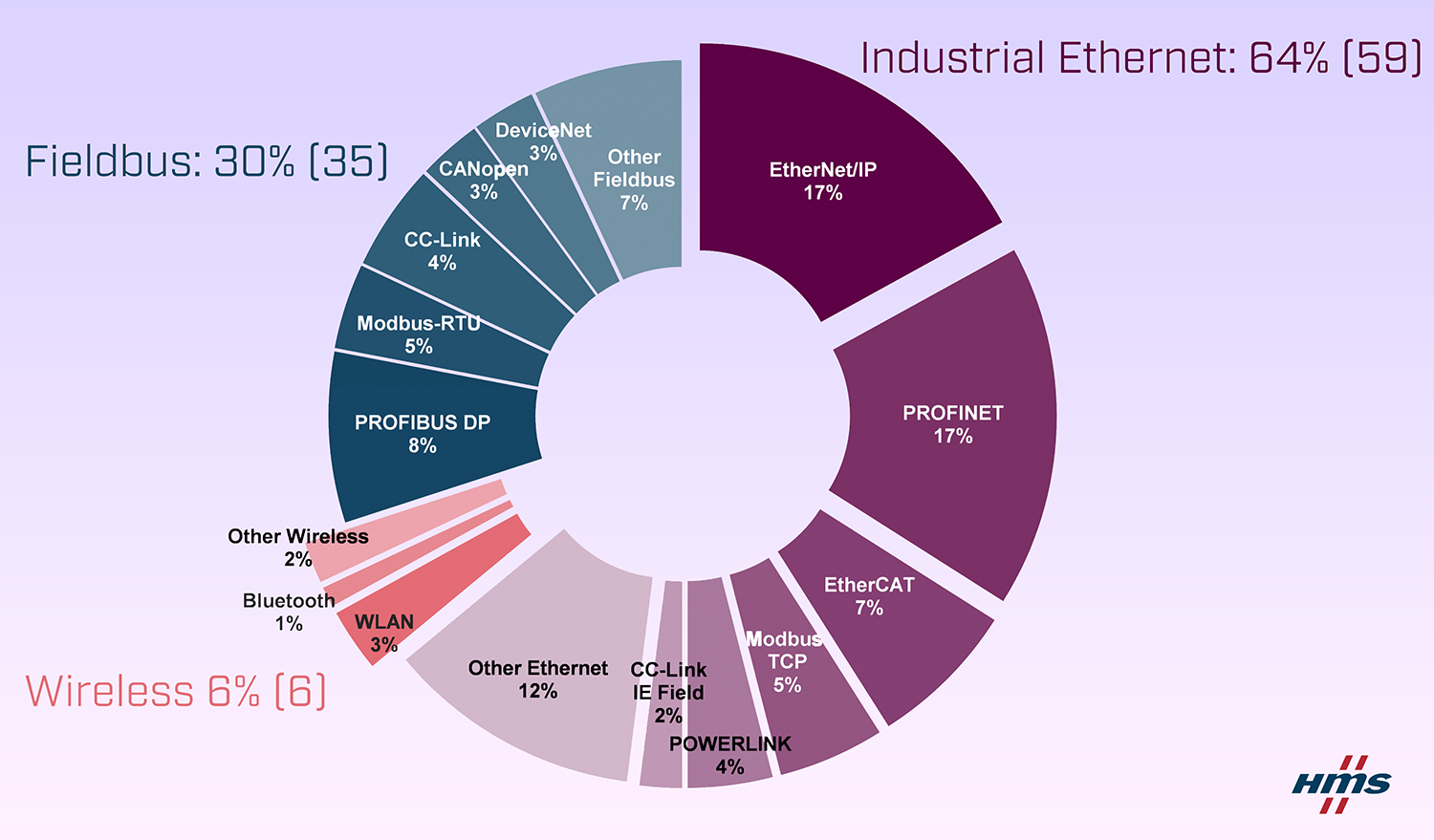
Industrial Ethernet market share increases as fieldbus decline continues
Mike Edwards
Features Ethernet/IP fieldbus Modbus Profinet Anders Hansson
Anders Hansson Industrial network connectivity for devices and machines is key to achieve smart connected factories. HMS Industrial Networks annual study of the industrial network market shows that Industrial Ethernet increases its market share to 64 percent of new installed nodes (59 percent last year), while fieldbuses drop to 30 percent (35).
The leading networks EtherNet/IP and Profinet share first place at 17 percent each. Wireless technologies stay at a 6 percent market share.
Halmstad, Sweden-based HMS Networks presents its annual analysis of the industrial network market, focusing on new installed nodes within factory automation globally. The company is an independent supplier of products for industrial communication and the Industrial Internet of Things. The 2020 study includes estimated market shares for fieldbuses, industrial Ethernet, and Wireless. Estimated growth rates are not included this year, the reason being the unique general market conditions due to the Coronavirus situation.
The study concludes that Industrial Ethernet continues to take market share from fieldbuses. Industrial Ethernet now makes up for 64 percent of the global market of new installed nodes in factory automation (compared to 59 percent last year). EtherNet/IP and Profinet share first place at 17 percent market share each. EtherCAT continues to perform well globally at 7 percent, and Modbus-TCP at 5 percent just passes Ethernet Powerlink at 4 percent.
 HMS estimates a fieldbus decline to 30 percent of new installed nodes (compared to a 35 percent last year). Profibus is still number one at 8 percent, for the first time accounting for less than 10 percent of the total industrial network market. Runners up are Modbus-RTU at 5 percent, followed by CC-Link at 4 percent.
HMS estimates a fieldbus decline to 30 percent of new installed nodes (compared to a 35 percent last year). Profibus is still number one at 8 percent, for the first time accounting for less than 10 percent of the total industrial network market. Runners up are Modbus-RTU at 5 percent, followed by CC-Link at 4 percent.
“We expect the industrial network market to grow steadily during the coming years, but due to the unique coronavirus situation which is now affecting the general business conditions globally, we have chosen not to include growth numbers in our 2020 analysis, only market shares”, says Anders Hansson, chief marketing officer at HMS Networks.
“So, only focusing on market shares this year, we see that Industrial Ethernet continues to drive industrial connectivity in factories, headed by EtherNet/IP and Profinet with EtherCAT in third place.”
Hansson continues: “Profibus is still the biggest fieldbus but has lost market share as the general decline for fieldbuses continues. Another interesting finding is that Modbus keeps doing well -both when it comes to fieldbus Modbus RTU as well as the Ethernet-based Modbus-TCP, indicating that factories do not refrain from using well-working technologies in their new installations just because they have been around for some time.”
Wireless technologies keep a 6 percent market share, with WLAN still being the most popular technology, followed by Bluetooth. “Wireless keeps its market share on a growing market which is not bad, but we expect the Wireless share to increase over time,” says Hansson.
“With all ongoing activities globally about wireless cellular technologies — such as Private LTE/5G networks — as enablers for next-level smart manufacturing, market demand will increase for wirelessly connected devices and machines to be included in the less cabled and flexible automation architectures of the future”.
Regional network variations
EtherNet/IP and Profinet are leading in Europe and the Middle East with Profibus and EtherCAT as runners up. Other popular networks are Modbus (RTU/TCP) and Ethernet Powerlink. The U.S. market is dominated by EtherNet/IP with EtherCAT gaining some market share. Profinet and EtherNet/IP lead a fragmented Asian market, followed by Profibus, EtherCAT, Modbus (RTU/TCP), and CC-Link/CC-Link IE Field.
The study includes the company’s estimation for 2020 based on number of new installed nodes in 2019 within factory automation. A node is defined as a machine or device connected to an industrial network. The presented figures represent its consolidated view, considering insights from colleagues in the industry, our own sales statistics and overall perception of the market.
This article was contributed by HMS Industrial Networks.
Print this page